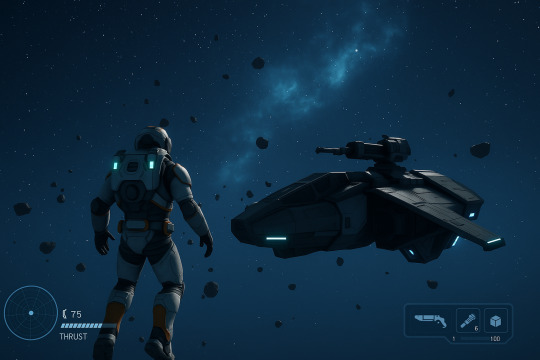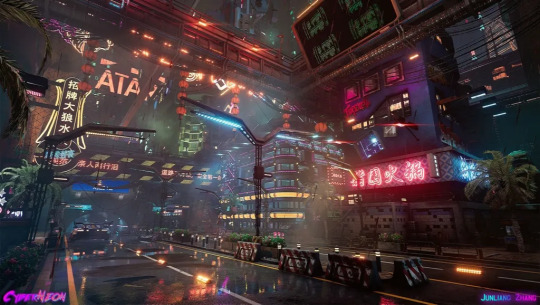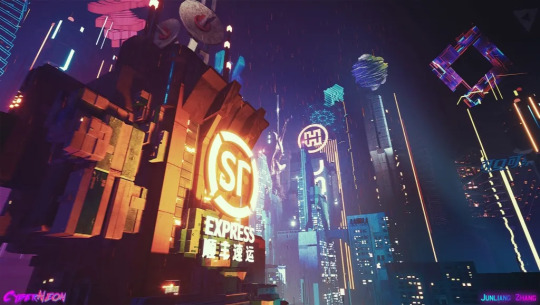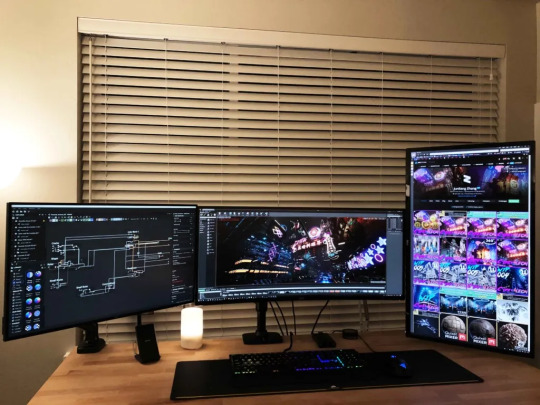#ue4 shader
Explore tagged Tumblr posts
Text
youtube
I just released a video game! It's a fancy-graphics remake of my 2013 marble-rolling puzzle game InFlux, and you can buy it on Steam or Epic right now, and I'd love it if you did, particularly if you left a positive review to reduce the likelihood of Steam never surfacing it to anybody and it not making any money.
Some years back I started making a remaster of InFlux on UE4 in my spare time. I just thought it would be a nice straightforward thing to do to keep InFlux playable and supportable into the future by moving it to a better engine, and I wasn't wrong, but I didn't consider how long it would take me to do it while also working. Now it's on UE5, and it's done, and you can play it. It's the same game, but with way better graphics and way less jank, having been remade basically from scratch in a new engine, sharing zero code with the original.
Initially, I had planned to do a relatively straightforward remaster, where the game would look, feel and perform a lot better just by being in UE4, but the art itself would be the same. Since I was only ever working on Redux in snatches of spare time and had to rewrite and redo everything, this took a couple years.
I had that version of the game ready to ship, with a trailer and everything, but got distracted, and coming back a year later, thought "this isn't remastered enough". I spent another couple years remastering it better, with nicer shaders, a more detailed world, etc, and had that ready to go, but got distracted again. Coming back a year later, I thought "this isn't remastered enough" and reworked most of the assets with higher polycounts, re-lit everything, added new photogrammetry-based assets, and had something really nice looking, and got distracted. By the time I came back to it again, UE5 was solid, so I reworked things again to take advantage of Nanite, Nanite tessellation, Lumen, virtual shadowmaps, and other new tech. So it's a remaster of a remaster of a remaster at this point.
The content is mostly the same, but there are some new things: some streamlined level designs and additional traversal puzzles in the overworld, some added interactions to give you more to do there than roll around, and a number of tweaks to existing puzzles. There's also an entire extra puzzle room that wasn't in InFlux that I think I must have just forgotten to put in, and a lot of minor quality of life improvements to smooth away a lot of the original's jank. Also, there are now hidden fireflies to find that unlock concept you can view in a gallery.
What kept me committed to doing this at the many times when I did not want to was the fans, who are not many, but are lovely and earnest, and also the realisation that a lot of folks played this when they were kids and would be excited to see it again. It's surreal to have an adult tell you that they loved your game when they were 9, but it's a big motivator too. Kids enjoy games on a better, less critical level than adults can; I really like knowing InFlux was that special thing for somebody. Thanks for the support, folks, and I hope you enjoy this thing.
4 notes
·
View notes
Text
Learning Godot 2023-11-14
Been spending the last week or so learning how to make stuff in Godot. It's the first time I've really felt that coding with text instead of UE4 Blueprints clicked. We've got basic schmovement, double jumping, coyote time, dashing, skidding to a halt, a half decent camera, all that good stuff. I haven't forgotten about Knight Game, as soon as I have the opportunity I'll be back on that! In the meantime, I might post more about my Godot escapades.
the nice dither effect is from here, i didn't make it: https://godotshaders.com/shader/ps1-psx-postprocessing/
2 notes
·
View notes
Text

Uplers offers a fast and reliable way to hire top Unreal Engine developers from India. Their platform connects you with the top 3.5% of AI-vetted UE4/UE5 talent in just 48 hours, making it ideal for game development, AR/VR, simulations, and architectural visualization projects.
🔹 Key Highlights:
🧠 Top 3.5% Developers: AI + manually vetted for skills in Unreal Engine, C++, Blueprints, multiplayer, lighting, shaders, and more.
⚡ Fast Hiring: Receive 3–5 developer profiles in 48 hours.
🌍 Timezone Flexibility: Hire developers who can work in your timezone (EST, UK, IST, etc.).
💰 Cost-Effective: Save up to 40% compared to Western hiring rates.
📊 Transparent Pricing: Starts at ~$2,500/month with clear breakdowns.
✅ Easy Process: 4 simple steps—Define → Discover → Evaluate → Onboard.
📄 Legal & Payroll Support: Handled through Employer of Record (EOR).
🔄 Flexible Contracts: Remote or onsite options. Cancel anytime within 30 days.
🔁 Free Replacement Guarantee: Lifetime replacement if the hire doesn’t meet expectations.
📈 High Retention: Developers stay longer due to performance coaching and monitoring.
For companies seeking skilled, affordable, and timezone-matched Unreal Engine developers, Uplers offers a complete hiring solution.
👉 Learn more: Hire Unreal Engine Developer & Programmers in June 2025 (Within 48Hours)
0 notes
Text
Migrating Projects to Unreal Engine 5: What to Expect and Watch Out For
So you're thinking about taking the plunge and migrating your project to Unreal Engine 5? Smart move! UE5 brings some genuinely game-changing features to the table, but like any major upgrade, there are some bumps along the road you'll want to navigate carefully.
As someone who's helped several teams make this transition, I wanted to share what you can realistically expect – both the awesome improvements and the "why is this breaking at 2 AM before our milestone?!" moments. Let's dive into what makes UE5 migration both exciting and occasionally hair-pulling.

The Good Stuff: Why UE5 Is Worth the Migration Effort
First, let's talk about why you're probably considering this migration in the first place. Unreal Engine 5 isn't just an incremental update – it represents a massive leap forward in game development technology.
Lumen: Global Illumination That Actually Works
Remember all those hours tweaking lightmaps and bake settings? Lumen changes the game with dynamic global illumination that actually works in production. This means:
No more waiting hours for lightmaps to bake
Realistic lighting that adapts to time of day changes
Light bouncing that updates in real-time as you modify your level
One developer I worked with literally cried tears of joy when they realized they could delete their entire lightmap optimization documentation. That's hundreds of hours of work suddenly made obsolete (in the best way possible).
Nanite: Say Goodbye to LODs
If you've spent countless hours creating LOD versions of models or battling with draw distance issues, Nanite will feel like magic:
Import film-quality assets directly into your game
Forget about manual LOD creation
Maintain incredible detail even at distance
Achieve polygon counts that would have melted your PC in UE4
Enhanced Editor Experience
The UE5 editor has received major quality-of-life improvements:
A more intuitive UI layout
Better organization for large projects
Improved Blueprint visual scripting
More responsive viewport performance
The Migration Reality Check: What to Watch Out For
Now for the part they don't always highlight in the flashy demo videos – the migration challenges. Having guided several unreal game development projects through this process, here are the pitfalls you should prepare for:
Materials Need Rework
Your carefully crafted materials might need significant updates:
PBR workflows have evolved in UE5
Many shader functions have been deprecated or changed
New material parameters are available, but require implementation
Material instances might need rebuilding
A mid-sized game I worked on had to assign a dedicated technical artist for two weeks just to update their material library. Plan accordingly!
Performance Profile Changes
UE5's performance characteristics are different from UE4:
CPU/GPU balance shifts with new rendering technologies
Memory requirements increase significantly
Some optimizations that worked well in UE4 might actually hurt in UE5
Mobile platforms require extra attention
One team I consulted for saw their memory usage double overnight after migration. They eventually got it back under control, but it wasn't the instant upgrade they expected.
Plugin Compatibility Nightmares
If your project relies heavily on third-party plugins:
Many haven't been updated for UE5 compatibility
Some will never be updated if they're abandoned
Marketplace assets might need updates
Your own custom plugins will need review and updates
Blueprint Refactoring Required
Your Blueprint logic will likely need work:
Deprecated nodes need replacement
Some function signatures have changed
New best practices have emerged
Performance-critical Blueprints might benefit from conversion to C++
Practical Migration Strategy: A Step-by-Step Approach
Having been through this process multiple times, here's my battle-tested approach to migrating unreal game development projects to UE5:
1. Create a Proper Testing Environment
Don't just dive in with your production project:
Make a separate branch in version control
Set up a clean UE5 project first
Create a small test scene with your core mechanics
Migrate this small slice before attempting the full project
2. Tackle Dependencies First
Before touching your main content:
Update or replace critical plugins
Test each third-party integration individually
Document any API changes you discover
Have fallback plans for unsupported features
3. Adopt a Phased Migration Approach
Don't try to migrate everything at once:
Start with core systems and mechanics
Then handle character and animation systems
Migrate levels and environments next
UI elements typically come last
Test thoroughly between each phase
4. Rethink Rather Than Port 1:1
Some systems deserve reimagining rather than direct porting:
Could your lighting setup benefit from Lumen instead of static lighting?
Would Virtual Shadow Maps solve issues you were working around?
Might some complex Blueprint logic be simplified with new features?
Could Nanite eliminate optimization headaches?
Real Talk: Timeline and Resource Expectations
Be realistic about what this process requires:
Small projects (solo/tiny team): 1-3 weeks
Medium projects (5-15 people): 1-2 months
Large production (15+ team): 3-6 months minimum
One studio I advised initially estimated their migration would take two weeks. Reality? It took them closer to two months. The good news is that much of that time was spent implementing new UE5 features that dramatically improved their game.
Specific Features to Watch During Migration
World Partition
UE5's World Partition system replaces the old level streaming approach:
Automatic streaming based on distance
Better organization for massive worlds
But requires significant rethinking of level design workflows
If you're using complex level streaming, expect to spend extra time here.
Animation Systems
The animation pipeline in UE5 has evolved:
Control Rig offers new capabilities
IK Retargeter changes how you handle animations
Full-body IK solutions are more accessible
For character-heavy games, this area requires special attention.
UI Systems
UE5 brings UMG improvements but also changes:
Some widget behaviors have changed
Responsive design features are expanded
DPI scaling works differently
Is It Worth It? The Honest Answer
After helping numerous teams through UE5 migration, here's my unfiltered take:
For new projects: Absolutely start with UE5. The learning curve is worth it, and you'll avoid migration altogether.
For early development projects: Yes, migrate now. The pain is minimal compared to the benefits.
For mid-development projects: It depends. Calculate the time cost versus benefits for your specific case. The newer your UE4 version, the easier the transition.
For projects near completion: Probably not worth it unless a specific UE5 feature solves a critical problem. Finish in UE4 and consider UE5 for your next project or DLC.
Final Thoughts: Embracing the Future of Unreal Game Development
Migrating to UE5 isn't just a technical exercise – it's about embracing a new generation of game development possibilities. The teams I've seen succeed approached it with both excitement about the possibilities and realistic expectations about the challenges.
Remember that even with the bumps along the way, UE5 represents a massive leap forward for creators. The lighting is better, the geometry is more detailed, the workflows are improved, and the possibilities are expanded. When the migration dust settles, you'll have a more capable foundation for bringing your creative vision to life.
Have you already started migrating your project to UE5? I'd love to hear about your experiences in the comments below. And if you're just beginning the journey, drop any questions you have – our community has probably faced and solved similar challenges already!
#game#mobile game development#metaverse#multiplayer games#nft#vr games#blockchain#gaming#unity game development
0 notes
Text
Major Study: Digital Media Art
Week-3 ( 28/05/2024 )
After successfully finishing the third week of work, I reached a significant milestone by completing the initial phase of the project, which involved meticulously crafting and texturing a detailed automotive model. Initially, there was a sense of uncertainty looming over me as I embarked on this project, unsure of how it would unfold and what the final outcome would be. However, as the week progressed, I could feel a wave of confidence wash over me, and by the end of it, I was pleasantly surprised with the results achieved during this crucial first stage. This experience not only bolstered my assurance in the direction of the project but also left me feeling content and motivated to tackle the upcoming phases with the same level of dedication and perseverance.

During the initial stages of working on a complex model and focusing on the texturing process, I found myself facing some challenges. At the outset, grasping the intricacies of manipulating the software proved to be quite a task. However, as I delved deeper into the project and spent more time understanding the tools and features at my disposal, I gradually gained a better understanding of how to navigate the software effectively. Moreover, I began to comprehend the significance of shaders in different sections of the model and how they contribute to the overall visual appeal. As I continued to familiarize myself with the software and its capabilities, I honed my skills in manipulating textures and shaders to enhance the model's realism and aesthetic appeal. This learning process enabled me to develop a more nuanced understanding of the software's functionalities and how they can be leveraged to create visually compelling and realistic models.

During the past week, I dedicated my time to enhancing the texturing of my vehicle in Blender, utilizing an addon that had piqued my interest during extensive research. This particular addon serves the specific purpose of rigging vehicles for use in Unreal Engine 4 (UE4). With careful attention to detail and precision, I successfully rigged the vehicle and seamlessly integrated it into the Unreal Engine environment, marking a significant milestone in my ongoing project. Looking ahead to the upcoming week, my focus will shift towards further developing the scene where my vehicle will come to life, as I continue to push the boundaries of my creative abilities and technical skills. The process of refining and optimizing the visual elements within my project will be a key area of exploration, as I strive to create a captivating and immersive experience for users. Through diligent planning and execution, I aim to bring my vision to fruition and achieve a seamless integration of all components within the project, ensuring a polished and professional end result that meets and exceeds expectations.

0 notes
Text
✌️Artists References

Junliang Zhang is from Shanghai, China. he is currently working at 3BLACKDOT in Los Angeles as a 3D environment artist, and he is also pursuing a Master's degree in Entertainment Arts and Engineering at the University of Utah.


From his work, you can see that it has reached the professional level of 3A games, and its choice of colors and backgrounds is very worthy of my study and reference.
🤔His pipeline

In the creative process, I observed that this artist employed a variety of different software tools to craft his artwork, showcasing a multifaceted approach to digital creation. The diverse range of software he utilized indicates a comprehensive and intricate workflow.
Here is the detailed pipeline he followed:
Unreal Engine 4: Initially, blockouts were conducted with simple white boxes to lay down the basic structure of the project.
Maya: Following this, low-poly meshes were created as the foundational elements of the design.
Maya: Subsequently, high-poly meshes were developed to add detail and depth to the composition.
Substance 3D Painter: Baking and texturing were then undertaken to bring realism and nuanced visual effects to the elements.
Substance 3D Designer/Quixel Mixer: Tiling procedural textures were crafted to enhance the visual continuity and cohesiveness of the scene.
SpeedTree: Organic foliage and trees were generated to infuse a sense of naturalism and life into the environment.
UE4: Finally, scenes were set up and unique shaders were created as needed to finalize the visual aesthetics and functionalities.
Once the workflow was clearly established, he commenced by blocking out some simple white boxes and developing basic shaders and rain effects, setting the stage for the pre-production phase.
✌️Refection
The best way to master new 3D modeling techniques and software is to experiment with them. I am planning to do this by trying different features, tools, and settings to create various different effects and outputs. For example, I could use MAYA to create organic and detailed models and then use UE4 to set up the environment. Then, I can import and merge these MAYA models to UE4 to make the perfect scene.
📖Reference
Zhang, J. (2019). Texturing Breakdown: Creating a Cyberpunk Environment. Adobe Substance 3D Magazine. Available at: https://www.adobe.com/products/substance3d/magazine/texturing-breakdown-creating-a-cyberpunk-environment-with-junliang-zhang.html
0 notes
Text
I always hated when professors required we use Unity in college. Like I get that the head of the game design department was an Unreal fanboy and had been ever since the Unreal Tournament 3 Editor was released to the public (seriously, he'd tell us all the time he started the 3D game design courses teaching Unreal Tournament 3 Editor and the Spore creature editor before they started using UDK). And other professors really wanted us to have experience in other gamedev tools, but at the time I'd used GameMaker Studio and UDK/UE4 and I just hated Unity. They'd always have these tools that were missing features, the school updated the software once per semester so we'd get stuck with buggy editions, and engine versions would drop/change functionality so drastically that sometimes tutorials from like 6 months prior would be unusable with the newest version. Don't get me wrong, I get the appeal. Compared to Unreal it's incredibly lightweight, and the shaders aren't baked into the source code so making games for lower build targets is significantly easier. But first you still had to make and publish a game, and I've never quite understood how anyone got that far.
Since graduating, just about everything the Unity corporation has done has been validation for not learning the ins and outs of making a game using the software. I've watched them make partnerships with the military, acquire businesses notorious for distributing spyware, and alter the licensing model on the engine to the point that a tool published by Epic Games is somehow the better deal both financially and ethically. Do you have any idea how hard it is to go lower than Tim Fucking Sweeney? And now they're hoping to charge 20 cents per installation, which they intend to use the Unity Runtime software to track?
0 notes
Text
The Forspoken PC port seems to have the same issue as Callisto Protocol - shaders. Basically, some games are compiling/building shaders for the first time as you go, so the game is going to run like dogshit on your first playthrough, but it should be fine on your second playthrough since the shaders have already been compiled.
A lot of PC ports do this before the game starts, if you've played HZD for the first time, the game told you to wait as its compiling/building shaders, so it's more stable. And guess what? The game ran smoothly. When I watched a Dead Space Remake stream, it did the same thing, the streamer even pointed it out. And the game is praised for its good optimization and consistent FPS (with some miniscule stutters here and there when it's loading a new area)
So yeah, basically a lot of publishers don't give a crap if the game runs well on PC, they're pushing the devs to churn it out as soon as possible and then we have these unoptimized messes that can potentially brick computers.
#I recommend watching digital foundry they explain it better than I could#since I'm not an expert#but the gist is that the shaders are usually the issue#I think it's prevalent with UE4 and UE5#chatter
7 notes
·
View notes
Photo


20220322
六角ジェネレーターで遊ぶ
六角形座標をテクスチャのUVに割り当てるとモザイク化できる
2 notes
·
View notes
Photo

[UE4] MORGAN BLADE - SHADERS STUDY by Sasha Grom https://www.artstation.com/artwork/9m3Y8N
9 notes
·
View notes
Video
tumblr
My realtime rain on glass shader for the Unreal engine. Part of a larger environment inspired by the rainy forests of the Pacific Northwest
4 notes
·
View notes
Video
youtube




993 notes
·
View notes
Photo









At the beginning of March 2019, I finished one of the longest and hardest project of my school work yet. It is a 3D environment in Unreal Engine 4. I’ve created it from scratch over 5 months. You can see more here:
https://www.artstation.com/artwork/L2k6E0
The programs I used are on each picture. The inspiration is definitely the Nasrid palace of the Alhambra in Granada, it is the most amazing place I have ever visited. Some of the textures are procedurally generated and I worked quite a bit on the Lion statue (my first real Zbrush sculpt) and the water shaders. You might notice some parallax mapping on the bricks too.
#myArt#2019#3D Scene#3DCAD#3dsmax#Autodesk#Original#Shaders#Texturing#UE4#Unreal Engine 4#substance#Zbrush#3DEnvironment#3D#3d sculpting#parallax#water shader#Digital Art
13 notes
·
View notes
Photo




Hi there, this is what I’ve been working on in terms of art assets. This new environment is far from being finished but I can call “done” the basic part of it now that it’s filled with a bunch of assets.
Also I made a really neat shader to enrich the floor texture without using vertex paint, here is how it works.

Here is a tweet where I explain it a bit more: https://twitter.com/Wabbaboy/status/1030039598548828160
92 notes
·
View notes
Photo

I've been working a bunch more on my Unreal Engine project but on lots of stuff I'm not ready to reveal yet - but I did just finish up a few different grey smoke particle systems for crash sites so here's a quick gif of the center area.
#UnrealEngine#Unreal#Unreal Engine#ue4#cel#cel shading#outlines#outline#sable#project sable#gameart#gamedev#shader#shaders#moebius#space#sci-fi#planet
16 notes
·
View notes